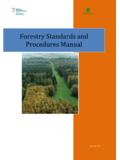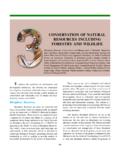Transcription of Agriculture, Fisheries and Conservation Department ...
1 Nature Conservation Practice Note No. 02 (Rev. Jun 2006) Page 1 of 6 Ref: AF GR CON 21/2 Measurement of Diameter at Breast Height (DBH) 1. Purpose The purpose of this Practice Note is to provide technical guidance to relevant government departments, landscape profession, horticulturists, gardeners and other interested persons for measurement of DBH. 2. Introduction DBH is a standard and the most common method of measuring tree dimension apart from tree height. It can be applied to monitor the growth of trees and compare the dimensions of different trees.
2 It is also one of the evaluation criteria for tree felling application. DBH refers to the diameter of tree trunk measured at breast level as a convenient way of measurement during which one does not need to bend his waist or climb up a ladder to take the measurement. For a more precise measurement, there is a need to standardize the breast height . In the United States, DBH is measured at a height 4 ft above ground. In situations where the metric system is adopted ( Australia, Canada, ), it is measured at m above ground.
3 In Hong Kong, the ETWB TCW No. 3/2006 on Tree Preservation defines a tree as a plant with trunk diameter measures 95 mm or more at a height of above the ground level. As such, in tree surveys for tree felling applications in Hong Kong, diameters of tree trunk are measured at m above ground in accordance with the international practice. For a tree with a clear straight or gradual tapering trunk, measuring the DBH is straightforward. However, in some other situations, there may be uncertainties as to how the DBH should be measured.
4 This Practice Note aims to provide some simple rules and tips, illustrated by representative examples, for DBH measurement in Hong Kong. Agriculture, Fisheries and Conservation Department Conservation Branch Nature Conservation Practice Note No. 02 Revised: June 2006 Nature Conservation Practice Note No. 02 (Rev. Jun 2006) Page 2 of 6 RULES: z Presence of tree fork below breast height Avoid the swollen part and measure the diameter of main trunk below the fork. The height of the diameter measurement and that of the fork should be noted ( 15 cm diameter measured at 75 cm whereas the fork at 87 cm).
5 Z Tree splitting into several stems close to the ground level Measure DBH of each stem separately and report the number of stems and diameter of each stem. If it is necessary to consolidate the diameters of various stems into a single index, the DBH for the tree as a whole could be taken as the square root of the sum of all squared stem DBHs. ( [(12cm)2 + (14 cm)2 + (17 cm)2]= 629= cm). z Vertically growing tree on a slope Measure DBH of the trunk on the upper side of the slope. Nature Conservation Practice Note No.
6 02 (Rev. Jun 2006) Page 3 of 6 z Leaning tree Measure DBH of the trunk on the side that the tree lean towards. z Tree with buttress Some trees possess buttress which would significantly affect DBH measurement. If the buttress along the trunk is up to a level above the DBH measurement, the diameter measurement should be taken just above the buttress and the height where the measurement is taken should be recorded. Keys: 1). Yellow Arrows ( ) indicate a height of m for DBH measurement 2).
7 Pink solid lines ( ) represent the position of DBH measurement 3). Yellow dotted lines ( ) represent the ground level. Nature Conservation Practice Note No. 02 (Rev. Jun 2006) Page 4 of 6 Fig. 3: A Diameter Tape, an alterative way to measure DBH, particularly for large trees. TIPS: z To increase accuracy and efficiency in DBH measurement, stand a m long stick next to a tree to set the level for measurement. z A Caliper gives a direct measurement of diameter and is more suitable for smaller tree with a more or less circular cross-section (see Figure 1).
8 For tree with an obviously elliptical cross-section, the DBH should be the average of any two Caliper measurements taken at right-angle (see Figure 2). A Diameter Tape (see Figure 3) is a measuring tape with the markings giving the circumference of the trunk on one side of the tape and the estimated diameter on the other side based on the pre-defined conversion factor (assuming a circular cross-section). If the Diameter Tape is not available, a normal measuring tape can be used to measure the circumference and calculate the DBH Fig.
9 1: Caliper Measurements, a convenient way to measure DBH, for relatively small trees 1st measurement taken at any direction = A 2nd measurement taken at right angle to the 1st one = B Fig. 2: For tree of elliptical cross-section. Diameter of Trunk = (A + B)/2 Nature Conservation Practice Note No. 02 (Rev. Jun 2006) Page 5 of 6 with the formula D = circumference/ . When taking DBH measurement for large tree, a Diameter Tape is preferable to a Caliper which may not have arms long enough for taking measurement. z When taking measurement with a tape, never presume the first attempt is accurate.
10 Loosen and re-tighten the tape a couple of times or slide it around the trunk to ensure the tape lies flat and is not obstructed by any swollen parts of the trunk. z No matter a Caliper or Diameter Tape is applied, it should ensure that the measurement is made perpendicular to the axis of the tree trunk (see Figure 4). 4. Enquires Enquiries on this circular should be addressed to the Senior Conservation Officer (Technical Services) at Agriculture, Fisheries and Conservation Department Axis of the tree trunk DBH measured at a level perpendicular to axis of trunk DBH measured at horizontal level WRONG Fig.













